K.I. Press's Blog, page 2
January 8, 2017
Taking the Scissors
I got a lot of use out the delete button over the past month while working on my thesis novel.
So far, the thesis process has gone down more or less like this:
Draft one: 60,000 words. Written over two summers, including all the outlining and such.
Draft two: 89,000 words. Included considerable cutting, so I added well over 30,000 words on the second draft, mainly for plot and character development. Written over one summer—one month, really.
Draft three: 66,000 words. I did a few thousand words of cutting at the end of the summer, but mainly this was done over the Christmas break. Included three or four new scenes, but basically it was a cull.
And how sweet the cull is.
I did not cut any chapters. Maybe one or two small scenes went. This was good, old-fashioned dross excision. Big chunks of exposition got the turf, excessive adverbs and adjectives, saying the same thing three ways in case the reader didn’t get it the first time, wordy constructions, all that jazz. It’s by no means perfect – I expect many more drafts to come – but on my way to getting this good enough for thesis submission, I’m pleased with the operation.
I always knew it was theoretically possible to edit away a quarter (at least) of one’s shitty draft without losing anything. I can now vouch that this is true. Same story, three-quarters of the words.
Of course, I’ve still got those words somewhere. O, all those archived files of words we decide not to use! Not to mention all the half-written and abandoned Facebook posts. (Apparently, Facebook keeps them all. Somewhere.)
Before we had a computer at home, we had an electric typewriter with eraser tape. You could backspace and delete letters. This was exciting. When the roll of eraser tape was done, you could unroll it and examine all the letters that had been erased. My sister used to keep all the old rolls. She called it her collection of mistakes.


May 6, 2016
Gender Representation in Student Screenplays
In my intro screenwriting class, we do table reads of the students’ short scripts before workshopping them. This year I started to notice that men seemed to be cast more than women.
There’s lot of research out there about unequal representation of gender in a variety of media. The Geena Davis Institute on Gender in Media is a good starting place–it specializes in research on gender representation in family films. It also has a good list of links to other research, including info on the dearth of female writers and directors.
The Playwrights Guild of Canada’s Equity in Theatre project exists to “remedy existing gender and related inequities in the theatre industry.” In the literary world, Canadian CWILA and U.S. VIDA keep track of whose books are being reviewed and by whom. And here’s an article about research on gender representation in children’s literature.
Many of these groups and research projects either take or are working towards an approach which tracks many varieties of inequity — by gender identity, race, sexual orientation, disability, and more.
So, I decided to see if the funny feeling I was getting in class played out by the numbers. I’d like to emphasize these are quite preliminary, rough numbers, using only the cast lists provided by the authors. “Lead” roles are determined only by the cast list and my gut feeling. I’d like to re-do this someday actually counting lines and perhaps taking other notes on the nature of the roles.
Narrators reading the scene directions were not counted. I counted speaking parts only, with the exception of silent films, where I counted all the parts. My sample size is relatively small, though bigger than many creative writing courses. Fifty-seven scripts were analyzed. I’ve analyzed only for gender.
[image error]
One part was written for a trans man, about 48% parts for women, and 51% parts for men. So far, so good. Men and women both tended to write slightly more parts for their own gender, an effect slightly more pronounced with male authors, but which worked out into roughly equal numbers of parts since the class makeup is over 60% women.


That’s for overall parts. Things look at bit different when we look at leading roles, a difference which is probably the source of the funny feeling I was getting in class:
[image error]
That would be about twice as many male leads as female leads. Here it is broken down by gender of author:


Male authors wrote male leads about three-quarters of the time — which I don’t find surprising. The most interesting number in all of this for me: women authors wrote leading roles for women only 39% of the time.
As an instructor, what can I do about this? Some ideas:
keep tracking numbers
include issue in curriculum before embarking on script writing (e.g. readings from the links I posted at the top)
source and use more examples in class that feature women in leading roles (I admit I haven’t done this at all, and usually use commonly referenced or easily available examples)
Any other ideas?


January 4, 2016
Sometimes A Light Sabre is Just a Light Sabre
Happy New Year! It must be time for me to post on my blog.
What I Did with My Winter Holidays
First, why do I hardly ever post? It’s not just “time,” because, let’s face it, we make the time for the things that we want to make the time for. I was telling folks in class today, I had “Watch Netflix” on my to-do list over the break, and as a result, I didn’t even, because putting it on a to-do list made it into work. (Hey Matt, the one thing I did watch was In Bruges, though! Thanks for the tip.)
Instead, I played video games and read books. I mostly only play one game. Final Fantasy VII. I played it when it came out in 1997, and I am too old to learn anything new, and I don’t really play games enough to justify buying anything else anyway. Plus, though I do have the original game and console somewhere in my basement, there’s an iPad port, and I always have the ol’ iPad with me.
There was absolutely no good reason for me to spend my precious leisure time playing Final Fantasy. This was just absolutely classic procrastination, with a strong hint of dopamine. I mean, sometimes it seems you are just SO CLOSE to earning a W-Summon in the Battle Arena, but then it takes another five hours for some reason. But to compensate for this phenomenal waste of time while pretending to be a little cartoon dude wielding a sword bigger than he is, I also spent some time reading a Very Serious Book which has itself been influential on storytelling in, among other things, games: Joseph Campbell’s The Hero with a Thousand Faces.
The Hero’s Journey
Oh, yes. I have been trying to read this book on and off for years, as I find it a bit of a slog. I’ve made better progress this time around, but I’m still only maybe a third of the way through, and man, I sort of want to punch him, except that he is dead and also may have been a nice man.
You can’t study screenwriting (or novel writing or game writing or comic writing or whatever) without hearing about The Hero’s Journey, ever since Christopher Vogler’s influential book on the subject in 1998. Vogler, who was a story editor at Disney, based his book on Campbell’s theory, applying it to story structure for screenwriting.
Campbell basically says that stories from around the world follow the same patterns, and then elaborates on those patterns. Which I’m willing to go with him on, because saying that you should recognize pattern in storytelling is kind of another way of saying that you should read a lot and learn from what’s successful in what you read (or consume in other media, too, but no matter what medium you want to write for, if you want to write, you need to read).
Vogler acknowledges the problem of the inherent maleness of the “hero” in the narrative journey, and the model he presents is flexible enough that the gendered nature of the journey didn’t seem like a big stumbling block to me when I read him. Not ideal, but it was something you could take and mess about with.
But now I’m reading Campbell, the legendary man himself. I’m paraphrasing here, but he says stuff like the hero needs to get past competing with the father in order to become “master of the world,” but that, if the character in the story is a woman, she has to similarly get past competing with the mother to become “the world that is mastered.” If I’m reading that right, he’s saying that the woman is the prize. People who defend this kind of thing will go all “you’re not meant to take it literally,” but if you’ve been paying attention you should know by now that language and symbols and stories matter and change the way that we see ourselves. (See Rebecca Solnit’s as-usual-excellent recent essay “Men Explain Lolita to Me.” )
The best part of the Campbell book for me, so far, is all the examples of stories from around the world, which he cites at length– the comparative mythology part. But he pulls the whole comparison through the filter of psychoanalysis (the book is from 1949), relying heavily on the traditional family as the be-all and end-all of human existence and leaving no room for anything other than a straight, male, cisgender hero.
Much more can, and has been, said about this, not by me. In Vogler’s nod to the topic alone, he cites a number of feminist takes on the hero’s journey. But my frustration with Campbell so far has just been one of those moments for me, you know, when you go WHAT THE HELL PEOPLE, IF THIS IS WHAT YOU HAVE BEEN CONSCIOUSLY BASING HOLLYWOOD MOVIES ON THEN NO WONDER!!!!!!!!!!!!! DIDN’T YOU NOTICE?????? DON’T YOU CARE????
Sometimes a Light Sabre is Just a Light Sabre
Which naturally brings me to Star Wars. George Lucas famously used Campbell in crafting the original series. A good article in the New Statesman the other day cited Campbell in a less than flattering way while discussing the seeming rise in female heroes lately (Rey, Furiosa, Jessica Jones). Let’s hope this rise is not a blip, because we’ve been here before. Thelma and Louise (1991) was supposed to usher in a whole new era. Did it? And that’s just at the edge of my adult memory – I’m suspecting there were moments like it before.
I’m a Buffy gal from way back. Reading Campbell has given me a new tingle of appreciation for a certain last-season episode in which Buffy gets transported back in time, to a mythic time, to meet the men who created the first Slayer, so they can basically give her a power boost for the final battle against evil. Thing is, it turns out that what they did to create the Slayer, and what they want to do to her again, is kidnap her, chain her to a rock, and force a demon on her to imbue her with demonic essence. Buffy says, no way, old dudes, I’ll find some other way to fight evil, and kicks their asses.
At the end of the series, of course, Buffy figures out how to fight evil by sharing her superpowers with others—she rejects the whole lone hero thing. My point? This mythic structure stuff can totally be messed with in a satisfying way. Buffy’s heroism still follows the pattern – descent to the underworld, fighting both inner and outer demons, encountering shape shifters, guidance from a wise mentor, death and resurrection, using her powers to change the “regular” world, check, check, check, check! Even her sharing of her superpowers fits the “return with the elixir” stage of the journey – the elixir being, in this case, heroism itself, which is the real twist on the structure.
Anyhoo. Enough Buffy talk. A casual glance at current Star Wars fan chatter does reveal some people commenting on how the essence of the Kylo/Rey conflict is potentially very gendered – not just, hey, a female hero! But, hey, a different manner of heroism! I’m not totally getting that yet, since there’s an awful lot of emphasis on daddies and light sabres. There was some interesting sexual subtext in the mind reading scene, though. (I’ll be murdered for likely misquoting, but is the line something like, “You know I can take from you anything I want?”)
It’s Late and I’m Tired Now
I also wanted to talk about Outlander and Game of Thrones. See, now I have something for next time. All part of the plan.
Back full circle: why I don’t much like blogging, and don’t do it often. Clearly, one reason is that I haven’t mastered the form. I’ve now been noodling about this topic for three hours (nearly four hours after a couple quick read-overs) and am at about 1400 words.
Also: I really put off making known my circuitous thoughts, because I feel like there’s no point in saying anything unless I’ve done a cartload of academic research to back up what I am talking about. Or at least, you know, finish the darn book before I shoot my mouth off about it. I’ve just committed all sorts of sins, not only in potentially misquoting Star Wars, but in, say, making sweeping generalizations about psychoanalysis without ever having studied it.
I’m basically reluctant to commit my informal noodlings to publication. I think I just have to get over this, because, heck, at least I’ve written something, and maybe someday with time and motivation aplenty, and after having finally achieved that W-Summon in the Battle Arena, I’ll take up Buffy scholarship and feminist comparative mythology and write an awesome paper.
But not today, and not on a blog.


September 7, 2015
Storyland
Well, I didn’t get as much writing done this summer as I would have liked, though I did finish a shitty first draft of a novel, which is something. I’m just about finished re-reading it, and boy, does it have holes (though I knew this as I was writing!). Now I just need to find the time to transcribe my notes into a legible form before I forget what I was talking about.
I did, however, get some reading done this summer, which is energizing. After, eventually, finishing Book 3 of the Knausgaard oeuvre, I decided to wait on Book 4 and move on to some other reading projects in the meantime. Among other things, I read two Canadian fantasy trilogies I’d long meant to read – Guy Gavriel Kay’s The Fionavar Tapestry and Thomas Wharton’s The Perilous Realm. I didn’t know much about the storylines of either of these series, but knew that Kay’s work was a classic, the thing that made him famous. One of Wharton’s novels for adults, Salamander, is a personal favourite, so I was interested in his YA fantasy trilogy–YA fantasy being a subject of interest to me right now—and a recommendation this spring reminded me to pick it up.
I enjoyed both series tremendously, though I was blown away by Kay’s masterwork. Its classic status is deserved, not to mention that, intended for adults, it spoke to me more directly than Wharton’s book for young readers. (This isn’t always a true distinction, though – I’ve also been re-reading Pullman’s His Dark Materials trilogy with my daughter, and although those books are ostensibly for young readers, their ambition, scope, complexity and artistry put much of writing, for adults or children, to shame.)
The weird thing about reading these two trilogies in succession: both feature a world where stories come from. Or, as my daughter has said: “Storyland… the place where all the characters in my books are real.” Fionavar is the place myths originate, and The Perilous Realm has much more of a fairy-tale flavour, but both lands are basically that: Storyland.
So, did Wharton use Kay as a source here? Well, who knows and who cares, really—dude’s an incredible writer and has a Ph.D., so I’d be surprised if he hadn’t read everything remotely related to the story he was working on. My daughter and I have been telling tales of our own Storyland to each other for years, ever since I needed something to keep her attention focused while walking to daycare. The idea is public domain (not to mention the myths and fairy tales—not so much my daughter’s fan fiction material), and even a quick glance in Coles revealed another book with the same premise.
There are only so many stories. The question is: why is your version the version only you can tell?


May 18, 2015
sallyito:
Exquisite Monsters 2: So, I’m still drawing an image...
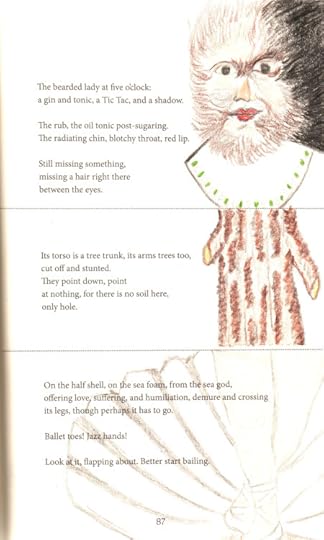
Exquisite Monsters 2: So, I’m still drawing an image every day inspired by K.I. Press’ Exquisite Monsters poetry book. Usually, I find a text that sparks my imagination and go Googling about for images. For the “bearded lady at five o’clock,” I found a portrait of a young bearded woman from the 16th century that I copied. The torso section featured a tree and this was relatively easy for me to draw without consulting any image. For the legs section, the mention of ‘half shell,’ ‘sea foam,’ and ‘sea god’ conjured up for me the famous Botticelli Aphrodite image which I consulted to draw the legs and the half shell. Of course, the feet are clad in ballet slippers.
May 13, 2015
sallyito:
I haven’t been on Tumblr for awhile but that hasn’t...
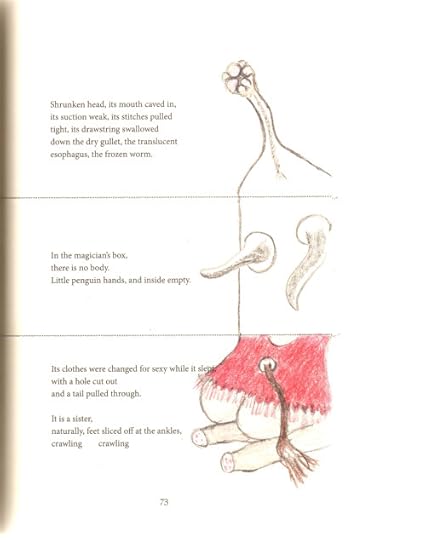
I haven’t been on Tumblr for awhile but that hasn’t meant I’ve stopped drawing! Recently, a poet friend of mine, K.I. Press, launched her latest poetry book called Exquisite MONSTERS. This book is meant to be interactive, and can be used for drawing. In the latter half of the book in a section called “Exquisite Monster (in interchangeable parts)”, the pages are divided into three portions with text roughly corresponding to the head, torso, and legs parts of the body. You can draw images alongside the text if you like, and then when you’re done, tear the page along the perforated lines and mix and match different heads with different torso or leg parts. I haven’t filled in the whole book yet but this is my first attempt at drawing one of the ‘exquisite monsters’ described on p.73. I take whatever portion of the poetic text that appeals to me as an image, and then usually Google it or something close to it and then imaginatively try and render something fitting. I’ve been drawing an image a day from whatever text appeals to me from the book that day, and this exercise is turning out to be a very fun way of trying to draw out of my head inasmuch as I can do so with the help of Google and my somewhat limited drawing experience!
May 5, 2015
Monsters Drawing Near
I’ve been a doodler for a long time, and this past winter gained a bit of doodling confidence when I took a grad course in making comics with the wonderful Sarah Leavitt. Here’s a link to some of the comics that we created in that class and in some of Sarah’s other classes.
There’s a poem sequence in my new book, Exquisite Monsters, that called out to me to draw. The sequences is made of head, body, and legs poems that make up a variety of “monsters.” You read the poems straight through, or mix them up into different complete monsters.
Now, my doodles are not in the book, but this is how it works. Only, with poems.
+
+
=
(You’ll have to buy the book to read the poem.)
The book is designed with blank pages, so you can draw in your own book. I don’t hold books as sacred objects, and really hope that readers will take me up on this invitation. Even if they can’t draw. Especially if they can’t draw! The great Lynda Barry points out that we all start out as artists and as writers, but we end up developing only what we are told we are good at. Obviously, if you don’t continue to study and practice an art, your skills won’t develop. But that doesn’t mean you should stop.
If you come to my book launch on Thursday night at McNally Robinson, not only will I make you draw, but you’ll get to watch an actual real artist draw: CreComm grad and amazing artist, writer, and human being Jason Booth will be live-drawing to my poetry reading.
In the meantime, here’s a “legs” poem from the book. If you go out and draw it, I’d love to see what you come up with.
A single papier mâché flipper, wrinkled like clay, dried
like a mud flat, like a new desert,
white and powdery like a hard new surface
made by hard new powers
and phenomena.
No water.
Just endless dive.


April 30, 2015
Here’s how the 3 #monster parts work together....
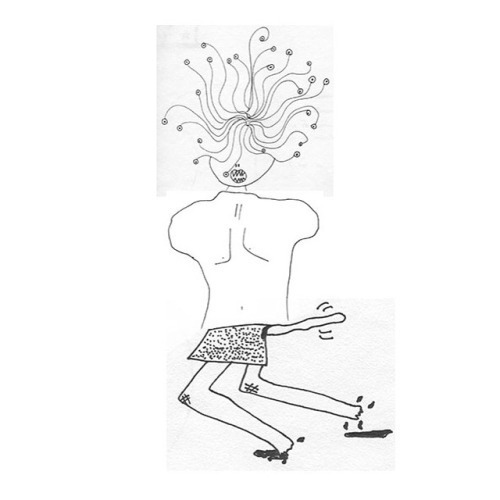
Here’s how the 3 #monster parts work together. #exquisitemonster #books #poetry #canlit
April 29, 2015
Today’s #exquisitemonster part is this odd set of...
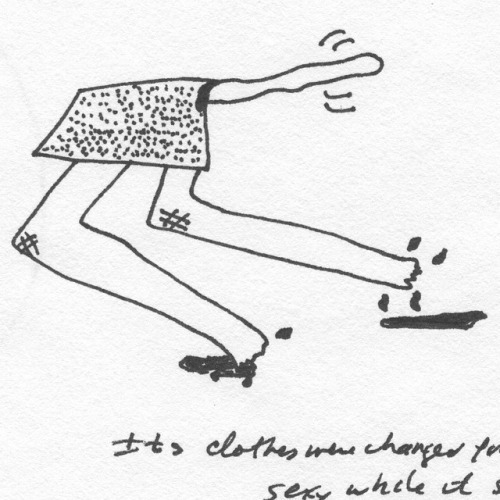
Today’s #exquisitemonster part is this odd set of legs:
Its clothes were changed for sexy while it slept
with a hole cut out
and a tail pulled through
It is a sister,
naturally, feet sliced off at the ankles
crawling crawling
#poetry #books #canlit #npm #poetrymonth #nationalpoetrymonth #monster
April 28, 2015
Today’s #exquisitemonster #monster:
Each unruly hair has...
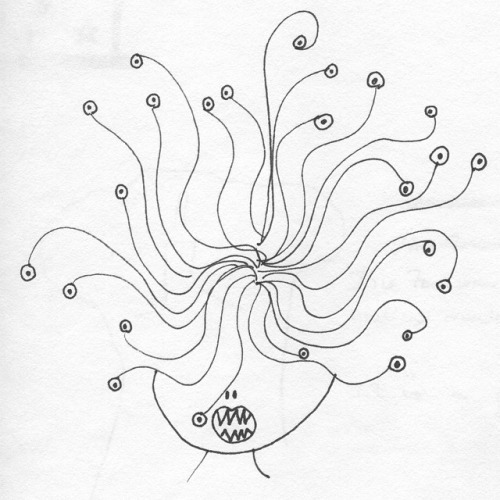
Today’s #exquisitemonster #monster:
Each unruly hair has a tiny eye on the end / They named it fibre optics / Everyone had a lamp like this / A thousand lamps, each swinging strand // These do not light up, but look at. And below / its mouth is carnivorous.
@turnstonepress



